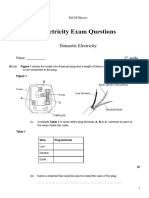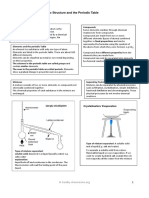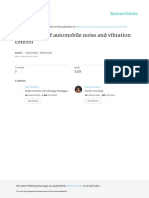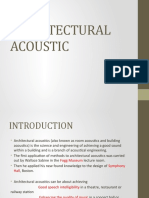Sound: Answer All Questions
Uploaded by
Nasser AlsowyanSound: Answer All Questions
Uploaded by
Nasser AlsowyanSOUND
IGCSE/O LEVEL PHYSICS
SOUND
EXERCISE
Answer all questions
Name:……………………………………………………………..
Date : ……………………………………………………………..
Marks ……..../…….... ……....% Grade ………
A* OR 9 ≥ 95%
A OR 8/7 ≥ 85%
B OR 6 ≥ 75%
C OR 5/4≥ 65%
D OR 3 ≥ 55%
E OR 2 less than 55%
COMPILED BY ZAIN UL ARFEEN Page 1
SOUND
MULTIPLE CHOICE QUESTIONS
1) A sound wave travels through air as a series of compressions and rarefactions.
Which row correctly compares the air pressure in a compression and the air pressure in
a
rarefaction to the air pressure nearby where there is no sound wave?
2) A sound wave has a certain amplitude and a certain frequency.
A second sound wave is quieter and lower in pitch than the first sound wave.
The second wave has
A a larger amplitude and a greater frequency.
B a larger amplitude and a smaller frequency.
C a smaller amplitude and a greater frequency.
D a smaller amplitude and a smaller frequency.
3) A fire alarm is not loud enough and the pitch is too low. An engineer adjusts the
alarm so that it produces a louder note of a higher pitch.What effect does this have
on the amplitude and on the frequency of the sound?
COMPILED BY ZAIN UL ARFEEN Page 2
SOUND
4) A dolphin has a range of audible frequencies of 150 Hz–150 kHz.
Which range of frequencies can be heard both by humans with good hearing and by
dolphins?
A 20 Hz–150 Hz
B 20 Hz–150 kHz
C 20 kHz–150 kHz
D 150 Hz–20 kHz
5) A girl notices that, when she shouts into a cave, she hears an echo.
Which wave property causes the echo?
A diffraction
B dispersion
C reflection
D refraction
6) A sound wave travels from a medium in one state into the same medium but in
another state.
This causes the speed of the wave to change from approximately 300 m / s to
approximately
3000 m / s.
Between which two states is the sound wave travelling?
A gas to solid
B liquid to gas
C liquid to solid
D solid to liquid
7) A sheet of ice floats on water. A source of sound S is positioned at the edge of the
ice sheet.Four microphones are placed equal distances from S.Which microphone
detects the sound from S first?
COMPILED BY ZAIN UL ARFEEN Page 3
SOUND
8) Sounds are produced by vibrating objects. A certain object vibrates but a person
nearby cannot
hear any sound.
Which statement could explain why nothing is heard?
A The amplitude of the sound waves is too large.
B The frequency of the vibration is too high.
C The sound waves are transverse.
D The speed of the sound waves is too high.
9) In an experiment to measure the speed of sound, a student uses a stopwatch to find
the time taken for a sound wave to travel from X to Y. She does this six times.
10) A swimmer is sitting on a rock at the sea shore looking at passing waves. He notices
that five complete wavelengths pass him in 20 s.
What is the frequency of this wave?
A 0.25 Hz B 4.0 Hz C 15 Hz D 100 Hz
COMPILED BY ZAIN UL ARFEEN Page 4
SOUND
11) A girl notices that when she shouts into a cave she hears an echo.
Which wave property causes the echo?
A diffraction
B dispersion
C reflection
D refraction
12) In a test, a car horn is found to be too loud and the pitch of the note is too high.
What information does this give about the amplitude and the frequency of the sound
wave produced?
13) A student wishes to measure the speed of sound in air. She plans to measure the
time between making a sound and hearing the echo from a cliff.
COMPILED BY ZAIN UL ARFEEN Page 5
SOUND
14) The diagrams show the wave shapes of two different sounds. The scales are the
same in each diagram.
15) Which row states two properties of sound waves?
16) A man holding a starting pistol stands 640 m away from a spectator.640 m
Spectator The spectator hears the sound of the starting pistol 2.0 s after seeing the
flash from the pistol. Using this information, what is the speed of sound in air?
A 160 m / s B 320 m / s C 640 m / s D 1280 m / s
COMPILED BY ZAIN UL ARFEEN Page 6
SOUND
17) A boy blows a whistle that has a frequency of 10 000 Hz. The boy’s friend cannot
hear the sound from the whistle. The friend has normal hearing.
What could be a reason why he cannot hear the sound?
A The amplitude is too large.
B The amplitude is too small.
C The frequency is too high.
D The frequency is too low.
18) A lighted candle is placed in front of a loudspeaker that is making a loud, steady
note. The candle flame vibrates because of the sound wave.
19) A student claps once when standing 100 m away from a large wall.
The speed of sound in air is 330 m / s.
How long after clapping does the student hear an echo?
A 0.30 s B 0.61 s C 1.7 s D 3.3 s
COMPILED BY ZAIN UL ARFEEN Page 7
SOUND
20) The diagrams represent two sound waves. The scales in the two diagrams are the
same.
21) The diagrams represent the waves produced by four sources of sound. The scales
are the same for all the diagrams. Which sound has the highest frequency?
COMPILED BY ZAIN UL ARFEEN Page 8
SOUND
22) A girl stands at a distance from a large building. She claps her hands and a short
time later hears an echo.
Why is an echo produced when the sound waves hit the building?
A The sound waves are absorbed.
B The sound waves are diffracted.
C The sound waves are reflected.
D The sound waves are refracted.
23) Sound travels by wave motion.
Which property of waves causes echoes?
A diffraction
B dispersion
C reflection
D refraction
24 A student listens to a machine that makes sounds of different frequencies. He can
only hear one of the sounds.
Which frequency of sound is the student able to hear?
A 2 Hz B 10 Hz C 2 kHz D 30 kHz
STRUCTURE QUESTIONS
1) Two students are measuring the speed of sound.
The students are provided with a starting pistol, a stopwatch and a long measuring tape.
The starting pistol, when fired, produces a loud sound and a puff of smoke at the same
instant.Describe how the students use the apparatus and how they calculate the speed.
You may draw a diagram.
COMPILED BY ZAIN UL ARFEEN Page 9
SOUND
2) A device at the bottom of the sea emits a sound wave of frequency 200Hz.
(i) The speed of sound in sea-water is 1500m/ s.
Calculate the wavelength of the sound in sea-water.
wavelength = ................................................................. [2]
(ii) The sound wave passes from the sea-water into the air.
State what happens, if anything, to
• the frequency of the sound, ...............................................................................
................................................................................................................................
• the speed of the sound. .....................................................................................
..............................................................................................................................[2]
3) (a) Radio waves, ultrasound and visible light are all waves.
State what is meant by ultrasound and suggest a value for the minimum possible
(i) frequency of ultrasound waves.
................................................................................................................................
................................................................................................................................
................................................................................................................................ [2]
(ii) State which of these waves are
• electromagnetic,
................................................................................................................................
• longitudinal.
................................................................................................................................
[2]
COMPILED BY ZAIN UL ARFEEN Page 10
SOUND
4) Ultrasound passes through both human flesh and bone.
Fig. 5.1 shows an ultrasound source sending an ultrasound wave into human flesh.
COMPILED BY ZAIN UL ARFEEN Page 11
SOUND
5) A loudspeaker produces a sound wave of constant frequency.
COMPILED BY ZAIN UL ARFEEN Page 12
SOUND
6) In the water of wavelength 0.25 m.
(a) (i) The frequency of the sound waves is 6.0 kHz.
Calculate the speed of the sound waves in water.
speed of sound waves in water = ...........................................................[2]
(ii) State a typical value for the speed of sound in air.
speed of sound in air = ...........................................................[1]
(iii) State and explain, for the sound produced by the loudspeaker, how the wavelength
of
the sound in air compares with the wavelength of the sound in water.
...........................................................................................................................................
.......................................................................................................................................[1]
(b) Sound is a longitudinal wave.
Explain what is meant by a longitudinal wave.
........................................................................................................................................[2]
(c) The sound emerges from the loudspeaker through a gap. The sound diffracts as it
passes through the gap.
(i) State how the width of the gap affects the diffraction.
.......................................................................................................................................[1]
(ii) State how the wavelength of the sound affects the diffraction.
.................................................................................................................................[1]
COMPILED BY ZAIN UL ARFEEN Page 13
SOUND
7) (a) (i) State a typical value for the speed of sound in air.
COMPILED BY ZAIN UL ARFEEN Page 14
SOUND
8) (a) (i) The pitch of a sound wave increases.
COMPILED BY ZAIN UL ARFEEN Page 15
SOUND
COMPILED BY ZAIN UL ARFEEN Page 16
SOUND
9) (a) The left-hand column of the table shows some possible speeds of a sound wave.
COMPILED BY ZAIN UL ARFEEN Page 17
SOUND
10) A vibrating source on a ship produces a sound wave that travels through the ocean.
The wave produced is a longitudinal wave.
BEST OF LUCK
COMPILED BY ZAIN UL ARFEEN Page 18
You might also like
- Living With Electricity Past Papers ANSWERS - PPTMNo ratings yetLiving With Electricity Past Papers ANSWERS - PPTM14 pages
- 7: Thermal Physics - Topic Questions Paper 6: Year Series Paper Number100% (1)7: Thermal Physics - Topic Questions Paper 6: Year Series Paper Number10 pages
- Science Support Material For Cambridge Checkpoint Registered StudentsNo ratings yetScience Support Material For Cambridge Checkpoint Registered Students7 pages
- Dot Point IB Physics Option Relativity SampleNo ratings yetDot Point IB Physics Option Relativity Sample14 pages
- g485 5.1.1 Electric Fields OCR A Physics NOTES For Revision or LearningNo ratings yetg485 5.1.1 Electric Fields OCR A Physics NOTES For Revision or Learning10 pages
- 2022 Sec 1 Express Science EOY Regent Secondary With AnswerNo ratings yet2022 Sec 1 Express Science EOY Regent Secondary With Answer36 pages
- 1.7 Energy Work and Pressure Igcse - Cie - Physics100% (1)1.7 Energy Work and Pressure Igcse - Cie - Physics26 pages
- Surya Varsani Academy: Fortnightly Test - 1 JUNE, 2020100% (1)Surya Varsani Academy: Fortnightly Test - 1 JUNE, 20202 pages
- Chapter-2-P2.01 Energy Stores, Transfers and ConservationNo ratings yetChapter-2-P2.01 Energy Stores, Transfers and Conservation21 pages
- Grade 9 Science Unit 3: Electricity: Chapter 9: Circuits AreNo ratings yetGrade 9 Science Unit 3: Electricity: Chapter 9: Circuits Are37 pages
- 9 Worksheet (AS) : Data Needed To Answer Questions Can Be Found in The Data, Formulae and Relationships Sheet.No ratings yet9 Worksheet (AS) : Data Needed To Answer Questions Can Be Found in The Data, Formulae and Relationships Sheet.3 pages
- Energy Transfer Checkpoint - Sec - 1 Physics ProgressionNo ratings yetEnergy Transfer Checkpoint - Sec - 1 Physics Progression8 pages
- Physics Worksheet For Grade - 10 (Part - 2) Ebenezer School (From K-G Up To Preparatory)No ratings yetPhysics Worksheet For Grade - 10 (Part - 2) Ebenezer School (From K-G Up To Preparatory)6 pages
- SC2 - States of Matter & Mixtures - Edexcel Practice PaperNo ratings yetSC2 - States of Matter & Mixtures - Edexcel Practice Paper8 pages
- Digital Devices - 2022 ICT IGCSE Edexcel QuestionNo ratings yetDigital Devices - 2022 ICT IGCSE Edexcel Question18 pages
- Cambridge International AS & A Level: PHYSICS 9702/22No ratings yetCambridge International AS & A Level: PHYSICS 9702/2216 pages
- Objective:-: 6.15 Monitoring and Tracking Systems 6.16 Satellite SystemsNo ratings yetObjective:-: 6.15 Monitoring and Tracking Systems 6.16 Satellite Systems4 pages
- Igcse/O Level Physics: Properties of Waves ExerciseNo ratings yetIgcse/O Level Physics: Properties of Waves Exercise21 pages
- General Wave Properties (Multiple Choice) MSNo ratings yetGeneral Wave Properties (Multiple Choice) MS2 pages
- Answer All Questions: Igcse/O Level Physics Light Exercise100% (1)Answer All Questions: Igcse/O Level Physics Light Exercise34 pages
- sv104 - Conference - Paper (NOISE Doise Meter)No ratings yetsv104 - Conference - Paper (NOISE Doise Meter)6 pages
- Study of Acoustical Property of Church: AcousticsNo ratings yetStudy of Acoustical Property of Church: Acoustics16 pages
- BS EN 61672-2-2003 Sound Level Meters Pattern Evaluation TestsNo ratings yetBS EN 61672-2-2003 Sound Level Meters Pattern Evaluation Tests44 pages
- NT Acou 053 - Rooms - Reverberation Time - Nordtest MethodNo ratings yetNT Acou 053 - Rooms - Reverberation Time - Nordtest Method7 pages
- An Analysis of Denis Smalley's Wind ChimesNo ratings yetAn Analysis of Denis Smalley's Wind Chimes8 pages
- An Overview of Automobile Noise and Vibration Control100% (1)An Overview of Automobile Noise and Vibration Control11 pages
- Living With Electricity Past Papers ANSWERS - PPTMLiving With Electricity Past Papers ANSWERS - PPTM
- 7: Thermal Physics - Topic Questions Paper 6: Year Series Paper Number7: Thermal Physics - Topic Questions Paper 6: Year Series Paper Number
- Science Support Material For Cambridge Checkpoint Registered StudentsScience Support Material For Cambridge Checkpoint Registered Students
- g485 5.1.1 Electric Fields OCR A Physics NOTES For Revision or Learningg485 5.1.1 Electric Fields OCR A Physics NOTES For Revision or Learning
- 2022 Sec 1 Express Science EOY Regent Secondary With Answer2022 Sec 1 Express Science EOY Regent Secondary With Answer
- 1.7 Energy Work and Pressure Igcse - Cie - Physics1.7 Energy Work and Pressure Igcse - Cie - Physics
- Surya Varsani Academy: Fortnightly Test - 1 JUNE, 2020Surya Varsani Academy: Fortnightly Test - 1 JUNE, 2020
- Chapter-2-P2.01 Energy Stores, Transfers and ConservationChapter-2-P2.01 Energy Stores, Transfers and Conservation
- Grade 9 Science Unit 3: Electricity: Chapter 9: Circuits AreGrade 9 Science Unit 3: Electricity: Chapter 9: Circuits Are
- 9 Worksheet (AS) : Data Needed To Answer Questions Can Be Found in The Data, Formulae and Relationships Sheet.9 Worksheet (AS) : Data Needed To Answer Questions Can Be Found in The Data, Formulae and Relationships Sheet.
- Energy Transfer Checkpoint - Sec - 1 Physics ProgressionEnergy Transfer Checkpoint - Sec - 1 Physics Progression
- Physics Worksheet For Grade - 10 (Part - 2) Ebenezer School (From K-G Up To Preparatory)Physics Worksheet For Grade - 10 (Part - 2) Ebenezer School (From K-G Up To Preparatory)
- SC2 - States of Matter & Mixtures - Edexcel Practice PaperSC2 - States of Matter & Mixtures - Edexcel Practice Paper
- Cambridge International AS & A Level: PHYSICS 9702/22Cambridge International AS & A Level: PHYSICS 9702/22
- Objective:-: 6.15 Monitoring and Tracking Systems 6.16 Satellite SystemsObjective:-: 6.15 Monitoring and Tracking Systems 6.16 Satellite Systems
- Igcse/O Level Physics: Properties of Waves ExerciseIgcse/O Level Physics: Properties of Waves Exercise
- Answer All Questions: Igcse/O Level Physics Light ExerciseAnswer All Questions: Igcse/O Level Physics Light Exercise
- BS EN 61672-2-2003 Sound Level Meters Pattern Evaluation TestsBS EN 61672-2-2003 Sound Level Meters Pattern Evaluation Tests
- NT Acou 053 - Rooms - Reverberation Time - Nordtest MethodNT Acou 053 - Rooms - Reverberation Time - Nordtest Method
- An Overview of Automobile Noise and Vibration ControlAn Overview of Automobile Noise and Vibration Control


































































































